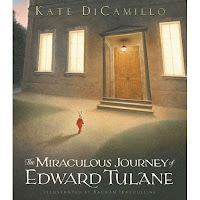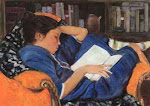From
StarMag
Review by
DAPHNE LEE THE MIRACULOUS JOURNEY OF EDWARD TULANE
By Kate DiCamillo
Illustrated by Bagram Ibatoulline
Publisher: Candlewick Press, 208 pages
(ISBN: 978-0763625894)
EDWARD Tulane is a china rabbit, finely dressed, trimmed with real fur. He has jointed limbs, leather shoes and a gold pocket watch. He doesn’t sound very cuddly, but he is an exquisite object, specially made for a little girl named Abilene.
Abilene adores Edward and Edward ... well, Edward thinks he is “an exceptional specimen”. The rabbit never ceases to “be amazed by his own fineness” and takes Abilene’s love totally for granted. Why wouldn’t she love such a beautiful toy?
His feelings are unusual. Toys in books are normally totally devoted to the children they belong to, but Edward is content to be loved and admired. When he is thrown overboard a ship and separated from Abilene, his first thought is, “Is my hat still on my head?”
I felt Abilene’s anguish at losing Edward but there was no pity for the toy. I realised, as I read the book, that I didn’t really care very much for Edward’s fate, but instead became involved in and concerned about the humans around him. In a way this was a relief.
Stories of lost, forgotten and abandoned toys usually affect me terribly. I would be absolutely horrified if it were proven that dolls, teddy bears and other playthings felt miserable if they were thrown away or neglected. I don’t think my conscience could cope!
As it is, I weep copiously whenever I watch that scene in Toy Story 2 when the doll Jessie sings about the little girl who loved her then forgot her. And as much as I loved Russell Hoban’s The Mouse and His Child when I first read it more than 15 years ago, I have put off rereading it because the young clockwork mouse who longs for a family just breaks my heart.
And so I approached The Miraculous Journey of Edward Tulane with trepidation. I actually read the last chapter first: Ahhh ... a happy ending.
However, I knew from the cover-blurb that things would get much worse before they started getting better. Still, I wasn’t prepared for just how miserable the book would make me.
It was not Edward Tulane’s misfortunes that upset me most. As the story progresses, the proud rabbit learns to open his heart and care for the humans around him, but each time he is separated from someone he has grown attached to, it was their loss I felt more than his.
Normally, toys in fiction are so terribly pathetic because the authors depict them as though they are living, breathing flesh and blood creatures.
It is their fate to be at the mercy of humans, much the same way that a helpless infant is at the mercy of his parents or carers.
Illustrations add to the pathos of a toy’s suffering as it is often given human facial expressions and body language.
Edward Tulane’s countenance, however, is unchanging. He stares ahead, blankly, out of eyes painted a brilliant blue. Unlike many of his fellow fictional toys he cannot move on his own accord. The illustrations show him in many situations, but whether he is decked out in lovely silk outfit or in grubby rags, his eye are always empty, his body either limp or posed by human hands.
But the people whose lives Edward becomes a part of are unforgettable and their stories compelling and powerful.
Because the reader is privy only to what Edward sees and hears, there is much about these lives that is implied and left to speculation, but the characters are so fully realised that it there is always the desire to know more. Edward’s fairytale ending offers satisfaction and closure only to a very limited degree.
There are still several lives that continue to haunt me, even after more than a month since I completed the
book.
Although Edward goes through a lot of hardship, things happen to him, he moves on and, eventually, finds love and happiness. Even his bleakest moments in the book cannot compare with the heartbreak that is faced by some of the other characters.
The fates of the siblings Bryce and Sarah Ruth, for example, are unspeakable and in this instance, I wished for a miracle for them and Edward Tulane be damned.
It was the illustrations that initially drew me to this book. They are by Bagram Ibatoulline and are beautiful, mysterious and, in some cases, disturbing. The picture on the cover is intriguing and rather bizarre.
The image of a little rabbit, walking upright towards the lighted doorway of a large house provokes many questions. Is the rabbit Edward Tulane? Does this scene depict the start of his miraculous journey or the end? Does the door lead to a good or bad place? What lies behind it?
Edward looks very small and vulnerable. Interestingly, although you can’t see his face, this picture shows him at his most expressive and sympathetic. This is probably because it is the only time you see him “moving” on his own.
There is purpose and courage in his carriage and so, despite his insignificant stature (or perhaps all
the more because of it), you cannot
help but feel admiration for the little rabbit.
Ibatoulline’s richly tinted and detailed pictures work very well with DiCamillo’s simple writing.
He is faithful to the text and, apart from on the cover, illustrates quite literally what DiCamillo describes.
The result is a moving and realistic portrayal of life as something filled equally with beauty and horror, joy and sorrow, tragedies and miracles.
All things considered, a toy that showed more emotion than Edward does would probably have made this story too mawkish for comfort.
But a toy that showed more emotion would also have seemed, to me, more deserving of the happy ending Edward gets.



